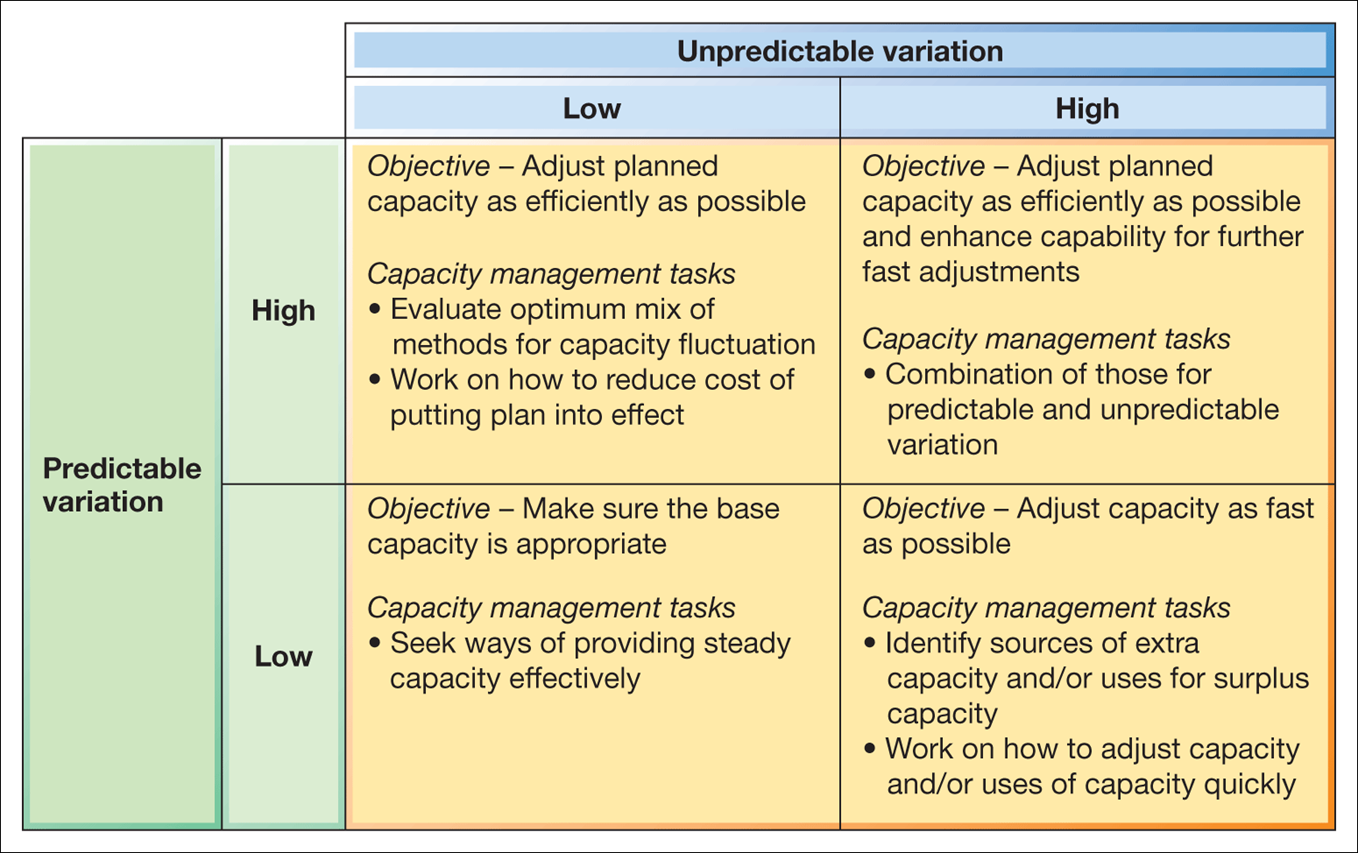Operations Management Lesson 6
1/41
There's no tags or description
Looks like no tags are added yet.
Name | Mastery | Learn | Test | Matching | Spaced |
|---|
No study sessions yet.
42 Terms
capacity management
understanding the nature of demand and supply (capacity) and attempting to reduce mismatches between them
firm operations
both internal capability and partner networks
seasonality in demand forecasting
any repeating pattern of demand annual, quarterly, monthly, weekly, daily or hourly
capacity
maximum level of value-added activity over a period of time that the process or operation can achieve under normal operating conditions
impact of time on capacity
level of activity and output that may be achievable over short periods of time is not same as capacity that’s sustainable on a regular basis
capacity leakage
a reduction in capacity, caused by both predictable and unpredictable losses
design capacity
theoretical capacity of an operation that its technical designers had in mind when they commissioned it
effective capacity
the capacity of an operation after planned losses are accounted for
actual output
capacity of an operation after both planned and unplanned losses are accounted for
demand management
shaping and managing customer demand
price differentials: adjust prices based on demand
scheduled promotion: use advertising to boost demand in slow periods
constrained access: limit when customers can access services
service differentials: vary service quality with demand
alternative offerings: introduce new products/services in quiet times
factors tending to increase base level of capacity
low fixed costs
need for high levels of customer service
high perishability
inexpensive fixed capacity
factors tending to decrease base level of capacity
high fixed costs
need for high capacity utilisation
ability to store output
expensive fixed capacity
important factors to consider in setting the base level
operation’s performance objectives
perishability of outputs
variability in demand or supply
level capacity
capacity remains fixed throughout planning period, regardless of demand fluctuations
level capactiy advantages
stable employment
high utilization and productivity
low unit costs
level capacity disadvantages
excess inventory build-up
unsuitable for perishable, trendy, or customized products
risk of low utilization in services (costly)
level capacity is best suited for
high-margin industries where losing sales is expensive (jewelry, real estate)
chase capacity
adjusts capacity to closely match fluctuations in demand
involves varying staff levels, work hours, and equipment
more complex and resource-intensive than level plans
chase capacity is best suited for
perishable goods
services that can’t store output (customer processing operations)
chase capacity advantages
reduces waste from overstaffing
minimizes inventory when demand is unpredictable
chase capacity challenges
operational complexity
may not be feasible in all environments
factors to consider for capacity management plans (demand management, level capacity or chase capacity)
predictable vs unpredictable demand variation
cumulative representations of demand and capacity
queuing principles to make capacity management decisions
longitudinal perspective that considers short- and long-term outlooks
inventory
accumulation of materials, customers or information as they flow through processes or networks
equipment effectiveness key indicators
availability rate
performance rate
quality rate
yield management
collection of methods used to maximize revenue from existing demand, especially useful when
capacity is relatively fixed
market can be clearly segmented
service cannot be stored in any way
service is sold in advance
marginal cost of making a sale is relatively low
the higher the base level of capacity
the less capacity fluctuation is needed to satisfy demand
nature of capacity management

inventory turnover rate
= COGS / Average inventory
A relatively low inventory turnover ratio may be a sign of
weak sales or excess inventory
a higher ratio signals
strong sales or effective inventory management, but may also indicate inadequate inventory stockingthat inventory is sold quickly and efficiently.
cycle inventory / working inventory
the stock a business holds to meet expected demand during a regular sales or production cycle
cycle inventory components
raw materials, work-in-progress, and finished goods ready for sale
cycle inventory replenishment
typically ordered in batches to balance ordering costs with storage expenses
return on assets
(revenue - costs) / (working capital + fixed assets)
holding costs / carrying costs
expenses a business incurs for keeping unsold inventory in storage
order costs
expenses associated with placing and receiving new inventory from suppliers and can be fixed or variable (i.e. warehouse capita costs, delivery of single order to location,…)
economic order quantity (EOQ) formula

co = Order cost per order
D = Demand
ch = Inventory holding cost per unit
Q = ordered quantity
re-order point (ROP)
stock level trigger for replenishing inventory. it helps businesses avoid stockouts and optimize their ordering cycles. 2 main factors that influence the reorder point
lead time
demand rate
key elements of capacity
scale
processing capability
inventory occurs in operations because of
the timing of supply and the timing of demand don’t always match —> needed to smooth the differences between supply and demand
five main reasons for keeping physical inventory
buffer inventory
cycle inventory (cope with an operation’s inability to make all products simultaneously)
allow different stages of processing to operate at different speeds and with different schedules
cope with planned fluctuations in supply or demand (anticipation inventory)
cope with transportation delays in the supply network (pipeline inventory)